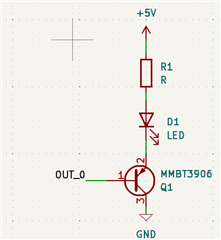Other Parts Discussed in Thread: LP5024, LP5867, LP5811, LP5810, LP5866T
Hi
I need to control 24 LED's intensity individually, TLC5947 seemed a good ideia but later on I found out some LED's take over 30mA (50mA to be exact).
So I thought about adding a mosfet and even a PNP transistor to control greater currents.
I set the reference resistor on the TLC5947 to 10K, which limits the current to greater values than my PNP transistor takes to get saturated.
By choosing the LED current limiting resistor carefully to its specific limit, the schematic below seems to be working just fine.
I can control the PWM dutycycle to each PNP and so i get 24 diferent intensities, each LED with a diferent maximum current (we the PWM to be at 100% dutycycle).
But seems quite odd not having a limiting resistor on the PNP base, or a base pullup to ensure to turns off every time.
But the schematic its working fine, there's no current at all flowing if I set a PWM to 0% dutycycle;
And although the 10k Reference resistor could lead to ~5mA on each output of the TLC5947, the fact that I'm limiting the emmiter current, ends up limiting the base current intake as well, in the end I get base currents around 0.2mA so achieve ~25mA on the LED.
What am I missing here? Should this work reliably?
Thank you!
Cheers, Luís Pereira.


